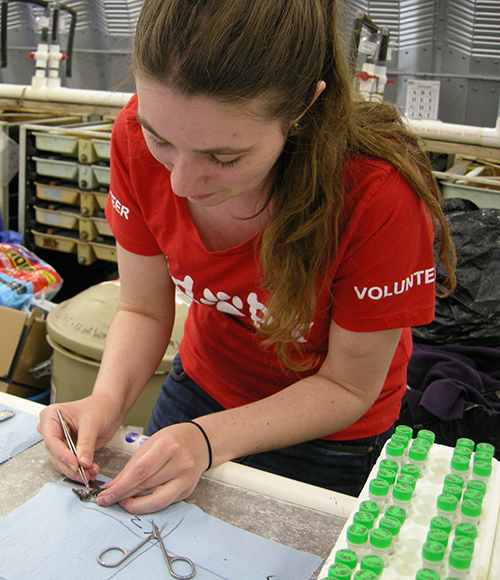Can probiotics change fish behavior?


Frank and her colleagues in Christina Semeniuk’s lab and comentor Daniel Heath’s lab at the University of Windsor in Ontario are trying to determine whether an unlikely intervention — a probiotic supplement in fish food — might help triploid Chinook salmon fare better. They’re starting with how the fish behave.
“Behavioral flexibility and sensitivity … would be an immediate measure for physiological (and neural genomic) change, given the connections between the gut–brain–behavior axis,” Semeniuk said.
Frank tested how probiotic supplements added to fish food affected the way hundreds of fingerling diploid and triploid fish respond to novel stimuli such as a glass bead tossed into the tank, a predator-shaped dummy passing overhead and an approaching human researcher. She will present her work as part of the Genomics poster session during the 2021 ASBMB annual meeting; you can see her talk and post questions while the meeting is underway.
In the future, Frank plans to integrate transcriptomic analyses with her behavioral studies, an approach known as behavioral genomics. Little is known about how triploidy affects genes related to learning and memory, so even if probiotics have little effect, she stands to learn something interesting.
Enjoy reading ASBMB Today?
Become a member to receive the print edition four times a year and the digital edition monthly.
Learn moreGet the latest from ASBMB Today
Enter your email address, and we’ll send you a weekly email with recent articles, interviews and more.
Latest in Science
Science highlights or most popular articles

Bacteriophage protein could make queso fresco safer
Researchers characterized the structure and function of PlyP100, a bacteriophage protein that shows promise as a food-safe antimicrobial for preventing Listeria monocytogenes growth in fresh cheeses.

Building the blueprint to block HIV
Wesley Sundquist will present his work on the HIV capsid and revolutionary drug, Lenacapavir, at the ASBMB Annual Meeting, March 7–10, in Maryland.

Gut microbes hijack cancer pathway in high-fat diets
Researchers at the Feinstein Institutes for Medical Research found that a high-fat diet increases ammonia-producing bacteria in the gut microbiome of mice, which in turn disrupts TGF-β signaling and promotes colorectal cancer.

Mapping fentanyl’s cellular footprint
Using a new imaging method, researchers at State University of New York at Buffalo traced fentanyl’s effects inside brain immune cells, revealing how the drug alters lipid droplets, pointing to new paths for addiction diagnostics.

Designing life’s building blocks with AI
Tanja Kortemme, a professor at the University of California, San Francisco, will discuss her research using computational biology to engineer proteins at the 2026 ASBMB Annual Meeting.

Cholesterol as a novel biomarker for Fragile X syndrome
Researchers in Quebec identified lower levels of a brain cholesterol metabolite, 24-hydroxycholesterol, in patients with fragile X syndrome, a finding that could provide a simple blood-based biomarker for understanding and managing the condition.

